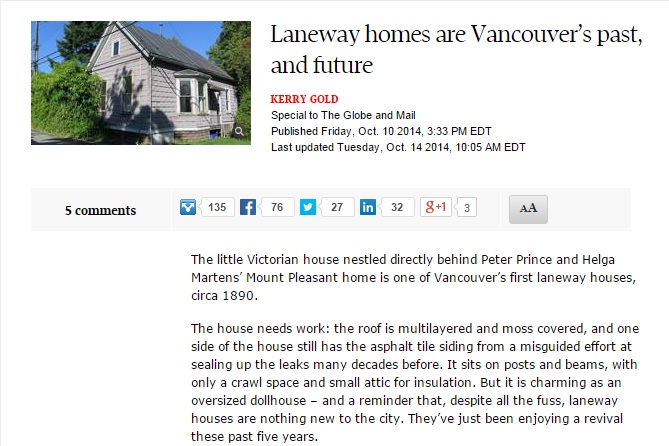A trying economy is proving to be a good teacher for Vancouver residents, bringing a 20th-century trend back to life.
Laneway homes are heavily associated with Vancouver and its rich history, the result of urban planning in the 1900s. The lots on which these homes were built, sized no less than 9.8 metres wide according to city code, saved homeowners thousands in mortgage and housekeeping costs. As Kerry Gold reports in The Globe and Mail:
Turn-of-the-century property owners would build a mini house at the back of the lot first, save up some money, and then build a bigger one at the front of the lot. And they’d always keep the smaller house because it was a great mortgage helper.
Laneway homes can be built in virtually all neighbourhoods of Vancouver. Downtown and West End (except the west shore), however, aren’t zoned for such homes, as well as large swathes of Kitsilano, Fairview, Mount Pleasant, and Strathconia. Areas beyond these neighbourhoods are fair game, but authorities recommend consulting with them first before building one of these homes.
At over 600 square feet, laneway homes are only a third as big as an average Canadian home. Yet, they are big enough for a family of four, provided they have the right design. They don’t go as high as bona fide two-storey homes, but are spacious enough for an average family’s needs.
The stable Vancouver real estate market is seeing a lot more of these tiny houses, as shown on property listing sites such as Vancouver Canada Homes’. These listings are shared on other sites, using a nationwide database, so a property that appears on one listing site also appears on VCH’s listings, making home sales more convenient.
One of the most affordable laneway homes in the listings right now is located along E 26th Ave., Renfrew Heights. Despite its below-average size of 516 square feet, it has three bedrooms and two bathrooms, sizeable enough to accommodate a slightly bigger family. Its proximity to the Skytrain system makes commuting around the city easy and convenient.
With code compliance, laneway homes like this can be expanded, and expected to swell in market value. This is particularly true in a market where demand is high, such as the Vancouver, B.C. real estate market. Not only are these homes practical for today’s fast-paced family life, they also help preserve the city’s cultural heritage.
(Source: Laneway homes are Vancouver’s past, and future, The Globe and Mail, October 10, 2014)
